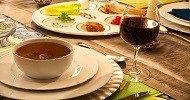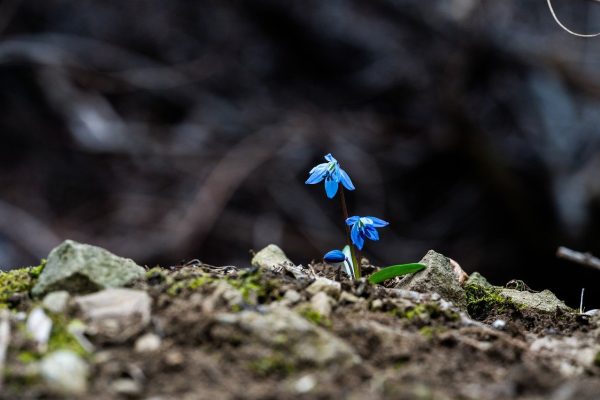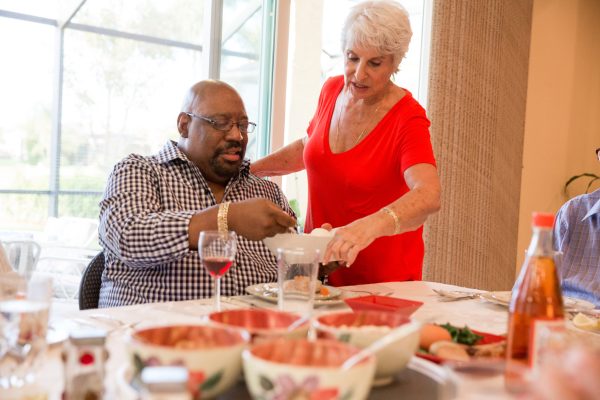The sederLit. Order. The festive meal conducted on Passover night, in a specific order with specific rituals to symbolize aspects of the Exodus from Egypt. It is conducted following the haggadah, a book for this purpose. The mystics of Sefat also created a seder for Tu B'shvat, the new year of the trees. table is the central physical space around which the seder unfolds. Even if you choose to hold part of your seder away from the table in a more comfortable space, your table should reflect the festivity and sanctity of the holiday. Crowded with dishes, glasses, bottles of wine and/or grape juice, flowers (not too high), and haggadot, the table must also have room for the following:
1. MatzahThe unleavened bread eaten on Passover that recalls the Israelite's hasty escape from Egypt when there was no time for the dough to rise. Matzah is also considered the "bread of our affliction," eaten while we were slaves.: You need enough matzah for everyone to eat but also three ceremonial matzot that are placed somewhere near the center of the table in a large napkin or special matzah holder. If your seder is being held before PassoverPassover is a major Jewish holiday that commemorates the Jewish people's liberation from slavery and Exodus from Egypt. Its Hebrew name is Pesakh. Its name derives from the tenth plague, in which God "passed over" the homes of the Jewish firstborn, slaying only the Egyptian firstborn. Passover is celebrated for a week, and many diaspora Jews celebrate for eight days. The holiday begins at home at a seder meal and ritual the first (and sometimes second) night. Jews tell the story of the Exodus using a text called the haggadah, and eat specific food (matzah, maror, haroset, etc). you might want to use egg matzah so that you can save “the real thing” for Passover. Some people use sh’mura matzah for the three ceremonial matzot. These matzot are handmade from wheat that has been watched from the time it was harvested.
2. The seder plate (k’ara): A traditional seder plate includes five or six symbolic foods: karpas, marorBitter herbs eaten at the Passover seder to recall slavery in Egypt, z’roa, beitzahEgg, charosetThe fruit and nut paste included in the Passover seder to represent the mortar the Israelite slaves used in Egypt. In Ashkenazic tradition, nuts are ground with apples and wine to make haroset for the Passover seder plate. Sephardic and other Middle-Eastern haroset typically uses dates as the base, often seasoned with ground ginger or cinnamon., and sometimes chazeret.
Karpas can be any vegetable for which the blessing over fruit of the earth is recited. Parsley or another green leafy vegetable is traditionally used. Jews of Eastern European descent sometimes use potatoes as it was the closest to a green vegetable that was often available during Passover.
For maror, bitter herbs, use horseradish root or a bitter lettuce. Put enough on the seder plate for everyone as the maror will be eaten during the seder.
The zro’a, shank bone, is a reminder of the Passover sacrifice. According to the TalmudThe rabbinic compendium of lore and legend composed between 200 and 500 CE. Study of the Talmud is the focus of rabbinic scholarship. The Talmud has two versions, the main Babylonian version (Bavli) and the smaller Jerusalem version (Yerushalmi). It is written in Rabbinic Hebrew and Aramaic. (Tractate Pesachim 114b) vegetarians may substitute a raw beet, which also bleeds when cut. The zro’a is not eaten at the seder.
The beitzah is a roasted hard-boiled egg. It is included on the seder plate in remembrance of the holiday sacrifice offered at the Temple. It can also be seen as a symbol of creation and the cycle of life and death, as eggs are eaten by mourners after a funeral. The beitzah on the seder plate is not eaten or used during the seder.
The charoset is a mixture of wine, fruits, nuts, honey and spices that symbolizes the mortar with which the Israelites made bricks during slavery. Askenazi charoset is usually made of apples, nuts, sweet wine, honey or sugar and cinnamon. SephardicJews of Spanish descent; sometimes used to describe Jews of North-African and Middle-Eastern descent. The term also describes the customs and practices of these Jews, often in comparison to those of Ashkenazi (Eastern European) Jews. charoset recipes contain dates, figs, apricots almonds and less or no wine. Make plenty of charoset, as it is always a favorite.
The sixth optional item on the seder plate is chazeret, a second bitter herb, which is added to the Hillel sandwich. You can use romaine lettuce or prepared horseradish for chazeret.
Many feminists also add an orange to their seder plates.
While all seder tables should include at least one central seder plate, some people prepare individual seder plates for each person. These plates should include all the ritual foods that will be eaten during the seder but they don’t have to include the beitzah or the z’roa.
3. Elijah’s Cup: Place an Elijah’s Cup at the center of the table. The cup should look different from all other cups on the table. Fill the cup with wine at the beginning of the seder or leave the cup empty for most of the seder and fill it before singing EliyahuElijah is a biblical prophet who is said never to have died. There are therefore many legends associated with Elijah. In the Talmud, unresolved arguments will be resolved when Elijah comes. He will herald the coming of the messiah. In Jewish ritual, Elijah is a liminal figure, arriving at moments of danger and transition – at a brit milah, a chair is put out for him, a cup is poured for Elijah at the Passover seder, and he is invoked at havdalah. His Hebrew name is Eliyahu. Hanavi.
4. Miriam’s Cup: A Miriam’s Cup is a new ritual object that is placed on the seder table beside the Cup of ElijahElijah is a biblical prophet who is said never to have died. There are therefore many legends associated with Elijah. In the Talmud, unresolved arguments will be resolved when Elijah comes. He will herald the coming of the messiah. In Jewish ritual, Elijah is a liminal figure, arriving at moments of danger and transition – at a brit milah, a chair is put out for him, a cup is poured for Elijah at the Passover seder, and he is invoked at havdalah. His Hebrew name is Eliyahu.. Miriam’s Cup is filled with water close to the beginning of the seder. See Miriam’s Cup for more.
5. Tambourine: Include tambourines on your table to offer children as well as adults an additional way to rejoice and participate. The instrument is deeply connected to the story of the Exodus as it was used by MiriamMiriam is the sister of Moses and Aaron. As Moses' and Aaron's sister she, according to midrash, prophesies Moses' role and helps secure it by watching over the young baby, seeing to it that Pharaoh's daughter takes him and that the baby is returned to his mother for nursing. During the Israelites' trek through the desert, a magical well given on her behalf travels with the Israelites, providing water, healing, and sustenance. and the Israelite women when they danced and sang at the shores of the Red Sea after having successfully left Egypt and escaped the Egyptian army (Exodus 15:20).
6. TzedakahCharity. In Hebrew, the word tzedakah derives from the word for justice. Tzedakah is not seen as emanating from the kindness of one’s heart but, rather, as a communal obligation. box: At communal seders before PesachPassover is a major Jewish holiday that commemorates the Jewish people's liberation from slavery and Exodus from Egypt. Its Hebrew name is Pesakh. Its name derives from the tenth plague, in which God "passed over" the homes of the Jewish firstborn, slaying only the Egyptian firstborn. Passover is celebrated for a week, and many diaspora Jews celebrate for eight days. The holiday begins at home at a seder meal and ritual the first (and sometimes second) night. Jews tell the story of the Exodus using a text called the haggadah, and eat specific food (matzah, maror, haroset, etc). or on interim nights include tzedakah boxes on your tables and donate it to a different organization or cause linked to Jewish women each year. If your seder is being held during Passover itself and you do not handle money on holidays (for Jewish legal reasons) we suggest that you put the tzedakah box near your candles and collect money before you light candles on the first night.
7. Other items: candlesticks and candles; a bowl with salt water for dipping the karpas; a pitcher of water and a bowl for hand-washing; hard-boiled eggs for before the meal (optional); pillows for sitting comfortably like free people; a plate of scallions reminiscent of the onions that sustained the Israelites in Egypt (Numbers 11:5) and the whips of the Egyptian taskmasters. These scallions are used by Iranian Jews during the Dayeinu in a playful reenactment of the taskmaster’s whipping.













